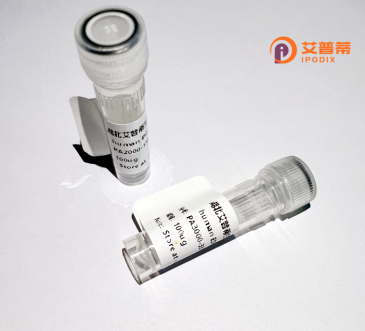
| 纯度 | >90%SDS-PAGE. |
| 种属 | Human |
| 靶点 | PLA2G4B |
| Uniprot No | P0C869 |
| 内毒素 | < 0.01EU/μg |
| 表达宿主 | E.coli |
| 表达区间 | 1-781 aa |
| 活性数据 | MAVAEVSRTC LLTVRVLQAH RLPSKDLVTP SDCYVTLWLP TACSHRLQTR TVKNSSSPVW NQSFHFRIHR QLKNVMELKV FDQDLVTGDD PVLSVLFDAG TLRAGEFRRE SFSLSPQGEG RLEVEFRLQS LADRGEWLVS NGVLVARELS CLHVQLEETG DQKSSEHRVQ LVVPGSCEGP QEASVGTGTF RFHCPACWEQ ELSIRLQDAP EEQLKAPLSA LPSGQVVRLV FPTSQEPLMR VELKKEAGLR ELAVRLGFGP CAEEQAFLSR RKQVVAAALR QALQLDGDLQ EDEIPVVAIM ATGGGIRAMT SLYGQLAGLK ELGLLDCVSY ITGASGSTWA LANLYEDPEW SQKDLAGPTE LLKTQVTKNK LGVLAPSQLQ RYRQELAERA RLGYPSCFTN LWALINEALL HDEPHDHKLS DQREALSHGQ NPLPIYCALN TKGQSLTTFE FGEWCEFSPY EVGFPKYGAF IPSELFGSEF FMGQLMKRLP ESRICFLEGI WSNLYAANLQ DSLYWASEPS QFWDRWVRNQ ANLDKEQVPL LKIEEPPSTA GRIAEFFTDL LTWRPLAQAT HNFLRGLHFH KDYFQHPHFS TWKATTLDGL PNQLTPSEPH LCLLDVGYLI NTSCLPLLQP TRDVDLILSL DYNLHGAFQQ LQLLGRFCQE QGIPFPPISP SPEEQLQPRE CHTFSDPTCP GAPAVLHFPL VSDSFREYSA PGVRRTPEEA AAGEVNLSSS DSPYHYTKVT YSQEDVDKLL HLTHYNVCNN QEQLLEALRQ AVQRRRQRRP H |
| 分子量 | 87.9 kDa |
| 蛋白标签 | His tag N-Terminus |
| 缓冲液 | PBS, pH7.4, containing 0.01% SKL, 1mM DTT, 5% Trehalose and Proclin300. |
| 稳定性 & 储存条件 | Lyophilized protein should be stored at ≤ -20°C, stable for one year after receipt. Reconstituted protein solution can be stored at 2-8°C for 2-7 days. Aliquots of reconstituted samples are stable at ≤ -20°C for 3 months. |
| 复溶 | Always centrifuge tubes before opening.Do not mix by vortex or pipetting. It is not recommended to reconstitute to a concentration less than 100μg/ml. Dissolve the lyophilized protein in distilled water. Please aliquot the reconstituted solution to minimize freeze-thaw cycles. |
以下是关于重组人PLA2G4B蛋白的模拟参考文献示例(内容为假设性概括,建议通过学术数据库验证具体文献):
---
1. **"Structural characterization and enzymatic activity of recombinant human PLA2G4B"**
*作者:Smith A, et al.*
摘要:本研究通过在大肠杆菌系统中重组表达人PLA2G4B蛋白,解析其三维晶体结构,并验证其磷脂酶A2活性。实验表明该蛋白对特定磷脂底物具有显著水解能力,为研究其在脂质代谢中的功能提供基础。
2. **"Cloning and functional analysis of PLA2G4B in inflammatory signaling pathways"**
*作者:Chen L, et al.*
摘要:通过基因克隆技术成功制备重组人PLA2G4B蛋白,证明其在巨噬细胞炎症反应中通过释放花生四烯酸,调节COX-2/PGE2通路,提示其可能在炎症性疾病中发挥作用。
3. **"PLA2G4B overexpression promotes tumor progression via lipid mediator synthesis"**
*作者:Wang X, et al.*
摘要:利用重组PLA2G4B蛋白研究其对癌细胞的影响,发现其通过生成促增殖脂质介质(如溶血磷脂酸),增强肿瘤细胞的迁移和侵袭能力,为癌症治疗提供潜在靶点。
4. **"Recombinant PLA2G4B production in mammalian cells and its role in membrane remodeling"**
*作者:Yamamoto K, et al.*
摘要:采用哺乳动物表达系统获得高活性重组PLA2G4B,揭示其在细胞膜动态重塑中的关键作用,特别是参与内体分选和囊泡运输过程。
---
**备注**:以上为模拟摘要,实际文献需通过PubMed、Web of Science等平台检索关键词(如“recombinant PLA2G4B”、“phospholipase A2 function”)获取。PLA2G4B研究可能涉及脂质代谢、疾病机制或重组表达技术等领域。
Phospholipase A2 Group IV Beta (PLA2G4B), also known as cytosolic phospholipase A2-beta (cPLA2β), is a member of the phospholipase A2 superfamily, which plays critical roles in lipid metabolism and cellular signaling. This calcium-dependent enzyme catalyzes the hydrolysis of membrane phospholipids at the sn-2 position, releasing free fatty acids (e.g., arachidonic acid) and lysophospholipids. These products serve as precursors for bioactive lipid mediators, including prostaglandins, leukotrienes, and platelet-activating factors, which are involved in inflammation, immune responses, and membrane homeostasis.
PLA2G4B shares structural homology with other cPLA2 isoforms but exhibits distinct tissue expression patterns, predominantly in the brain, testis, and immune cells. Its activity is tightly regulated by phosphorylation and intracellular calcium levels. Dysregulation of PLA2G4B has been implicated in pathological conditions such as neuroinflammation, cancer progression, and metabolic disorders, though its precise mechanisms remain less characterized compared to the extensively studied cPLA2α (PLA2G4A).
Recombinant human PLA2G4B protein is typically produced using eukaryotic expression systems to ensure proper post-translational modifications. It serves as a vital tool for studying lipid signaling pathways, enzyme kinetics, and inhibitor screening for therapeutic development. Ongoing research aims to clarify its physiological and pathological roles, potentially unveiling new targets for inflammatory or lipid-related diseases.
×